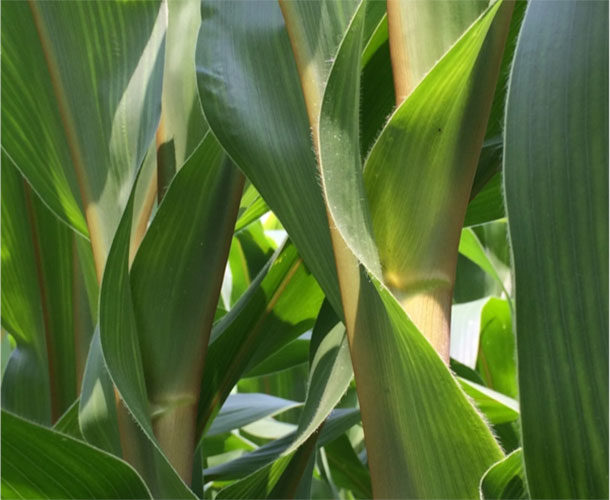Among corn silage hybrids, there is renewed interest in brown mid-rib (BMR) hybrids because they can help drive high milk production.
Is high fiber digestibility corn silage magical?
While cows need fiber for optimal rumen function, too much fiber can limit the potential energy available for milk production. With highly digestible forages, more pounds of fiber can be fed (dry matter intake increases) and more energy is available in each pound, or both.
Here is where the magic begins: When you can feed more forage fiber and have more energy available for milk production, the typical result is higher milk production or higher feed efficiency. While increased milk production is not always seen, it is nearly a 100 percent guarantee that low-quality corn silage will not give you top-end production with your dairy cows.
Where does BMR rank?
BMR corn hybrids rank as the most digestible corn silage type available today. BMR hybrids can bring a 10 percent or greater increase in fiber digestibility, leading to better animal performance when fed to a high-producing dairy cow.
BMR hybrids have low lignin content, an indigestible fiber component. With less lignin, there are fewer links to digestible fiber fractions. Rumen microbes gain better access to cellulose and hemicellulose in BMR silage, resulting in higher feed intakes and, ultimately, more energy available for milk production.
When fed to cows where dry matter intake is limiting production, BMR hybrids have their greatest success. Feeding it to early lactation dairy cows often helps increase peak milk production. Higher peak milk production nearly always translates into higher total lactation yields.
How much does this magic cost?
The magic of BMR corn hybrids has several cost factors. These include agronomic performance, forage yield performance, seed price and additional feed intakes. When planting a BMR hybrid, your expectations for several key agronomic traits need some adjustment.
First, the reduced lignin content of BMR hybrids may lead to a higher risk of plant lodging or bowing in the presence of high winds. Second, the overall yield potential remains 5 to 10 percent below top non-BMR silage hybrids. Some growers have observed less drought tolerance and lower starch content of silage. Breeding has helped improve the agronomic and yield performance of BMR hybrids recently by working with elite genetic backgrounds. So while these risks still exist, they are lower than they once were.
Initial costs of planting, growing and harvesting BMR corn silage seem high (including an aggravating factor when standability issues arise). However, the real cost measurement must include the digestibility factor and its positive influence on milk production. When combining forage yield, energy content and fiber digestibility into nutrient yields per acre, BMR hybrids often offer the return-on-investment advantage over non-BMR corn hybrids.
How do I get the most from BMR corn silage?
First and foremost, taking advantage of BMR corn silage requires planning. Develop close working relationships with your dairy nutritionist and seed sales professional. To help you realize the advantages of BMR corn on your farm, here are a few success factors:
- Meet with your nutritionist and seed sales professional during the winter months to plan how you will grow and use BMR on your farm.
- Identify field locations that will give you the best agronomic performance.
- Develop fertilization and pest-protection plans to help drive maximum forage yield.
- Monitor your crop in season to identify issues and to observe silking and grain maturity.
- Determine where you will store the BMR silage – preferably, separately from non-BMR silage – so you can access it when needed.
- Be prepared to harvest in a timely manner, when the whole-plant moisture is 62 to 68 percent.
- Use a kernel processor and adjust chop length at harvest based on your nutritionist’s goals. In many cases, nutritionists desire a slightly longer chop length (19 to 21 mm) to help with physically effective fiber levels.
- Apply a proven inoculant product to preserve and protect this high-value silage. Many growers use a L. buchneri aerobic stability inoculant to help keep feed stable through feedout.
- Test your forages frequently at feedout, and make ration adjustments recommended by your nutritionist. Make sure your nutritionist is adjusting the ration for higher fiber digestibility and intake rates.
- Monitor your cows and fine-tune your ration as needed to optimize feed utilization and milk production. Pay special attention to manure consistency, milk components and milk urea nitrogen (MUN), and adjust the ration as needed.
The foregoing article is provided for informational purposes only. Product performance is variable and subject to a variety of environmental, disease and pest pressures. FG

-
Dan Wiersma
- Integrated Feed Solutions
- DuPont Pioneer
PHOTO: Brown mid-rib corn hybrids are distinctive for the brown-colored rib. These forages tend to have higher digestibility in the cow's ration. Photo provided by Dan Wiersma.











